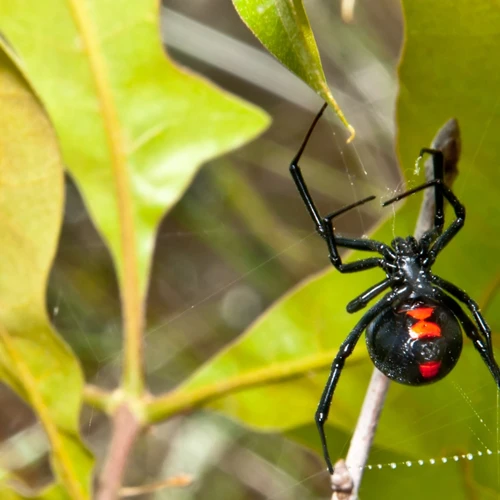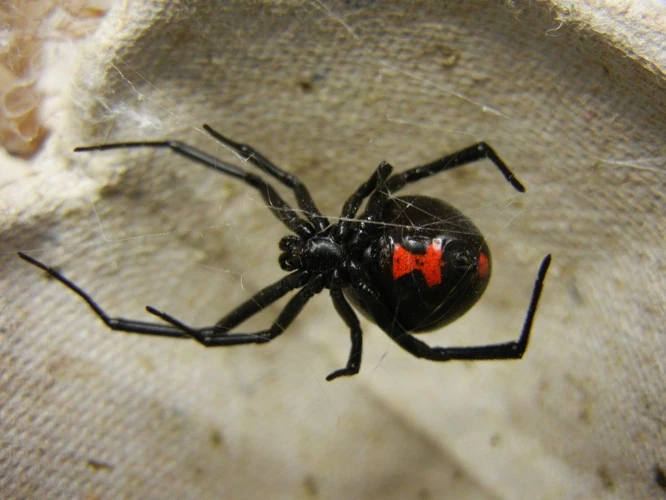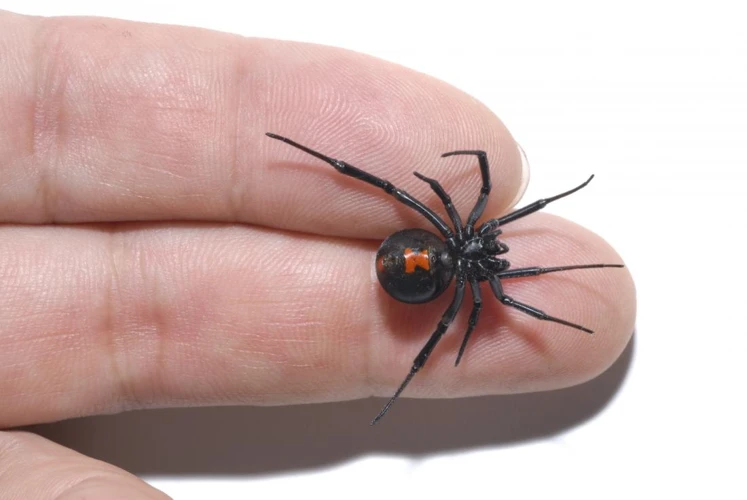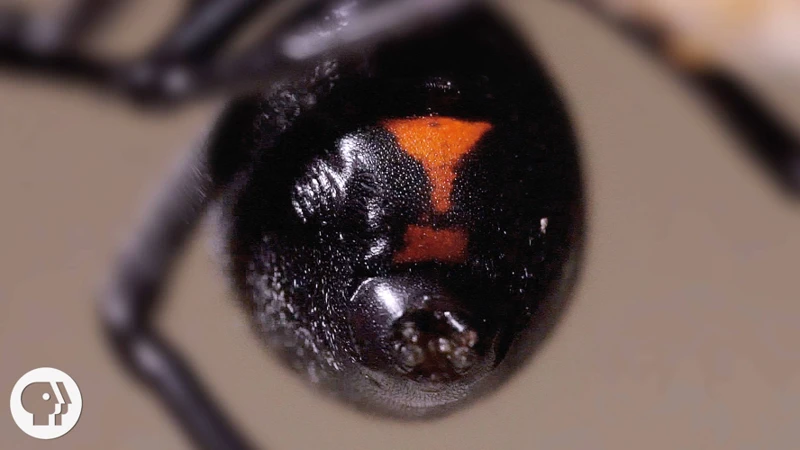As we venture into the great outdoors, we are bound to come across some creepy crawlies, but few strike fear in our hearts like the black widow spider. Known for their venomous bite and the infamous red hourglass on the female’s abdomen, black widows are a staple of the horror genre. However, there seems to be some confusion about the danger posed by male black widows. Do they bite humans, and if so, should we be concerned? In this in-depth article, we will explore all the facts surrounding male black widows and their potential threat to humans.
What are Black Widow Spiders?

Black Widow spiders are a type of arachnid that are known for their unique appearance and venomous bite. These spiders are found in various regions of the world and are known to be highly dangerous. They have a notorious reputation for their venom, which can have serious health effects on humans. The female Black Widow spiders are the most well-known type of Black Widow, but there is another group that often goes unnoticed: the male Black Widow spiders. In the following sections, we will explore the physical and behavioral characteristics of these fascinating spiders and learn more about their impact on human health.
Physical Description
Physical Description: Black Widow Spiders are known for their unique appearance. They have a shiny black color and their body is often marked with a red hourglass shape on the underside of their abdomen. The red hourglass is used to identify the spider as a Black Widow. They are small in size, averaging about half an inch in body length. Black Widows have eight legs and two main body parts, the cephalothorax and the abdomen.
| Physical Characteristics | Description |
|---|---|
| Color | Shiny black with a red hourglass shape on the underside of the abdomen |
| Size | Average half an inch in body length |
| Legs | Eight |
| Body Parts | Cephalothorax and abdomen |
Black Widows have unique fangs that are used to inject venom into their prey. The fangs are located at the front of their cephalothorax. These fangs allow the spider to bite and immobilize their prey before consuming them. The venom secreted from the Black Widow Spider’s fangs can be deadly to their prey, but only poses a threat to humans in rare cases.
If you want to learn more about the anatomy of the Black Widow Spider’s fangs and venom, be sure to check out our article on the topic.
Behavioral Patterns
Behavioral Patterns
Black widow spiders are primarily known for their behavior of consuming their male partners after mating. However, male black widow spiders are not always cannibalized by the females. Research has shown that the likelihood of being cannibalized depends on a number of factors including the size and hunger of the female, as well as the size and age of the male.
In addition to their cannibalistic tendencies, black widows also have several other behavioral patterns that are unique to their species.
| Behavior | Description |
|---|---|
| Web-spinning | Black widows are highly skilled at spinning intricate webs that they use to catch their prey. Their webs are strong and sticky, and they are often woven into irregular shapes to confuse their prey. |
| Nocturnal | Black widows are primarily active at night and will hide in crevices or under rocks during the day. |
| Prey hunting | Black widows are skilled hunters and feed on a variety of insects and other small prey. |
| Mating rituals | Male black widows perform elaborate courtship rituals in order to avoid being killed by the female. The ritual usually involves the male producing vibrations on the female’s web with his legs, and presenting her with a gift of food. |
Understanding the behavioral patterns of black widow spiders can help individuals to avoid potential encounters with these venomous creatures. It is also important to note that while male black widows are less venomous than females, their bites can still be dangerous and should be taken seriously. For more information on the health risks of black widow bites, visit /health-risks-black-widow-bites/.
Are Male Black Widow Spiders Dangerous to Humans?

Are male black widow spiders a danger to humans? While black widow spiders are infamous for their venomous bites, there is some debate over whether male black widows can be dangerous to humans. The answer is not straightforward and depends on several factors that we’ll explore in this section. It’s crucial to know the risks associated with male black widows and their bites before taking any necessary precautions. In this section, we will discuss the potential bite risk and the symptoms and treatment of a male black widow spider bite.
Bite Risk
Male black widow spiders have a much lower risk of biting humans compare to the females. The male black widow spider’s mouth part is not large enough to bite through human skin. They are not aggressive towards humans and only bite when threatened. However, if a male black widow spider does happen to bite, it is usually because it was accidentally crushed or grabbed.
It’s important to note that even though the chances of being bitten by a male black widow spider are low, female black widow spider bites can be dangerous and even fatal in some cases. According to the Centers for Disease Control and Prevention, black widow spider venom is 15 times stronger than that of a rattlesnake. The venom of the black widow spider affects the nervous system and can cause severe muscle pain, cramps, and spasms. In extreme cases, it can cause difficulty breathing and even paralysis.
It’s essential to take black widow spider bites seriously and seek medical attention immediately if bitten. Delaying treatment can lead to further complications and long-term damage.
There are some risk factors that increase the chances of getting bitten by a black widow spider. For example, people who work outside or in buildings with undisturbed areas where black widow spiders tend to build their webs are at higher risk. People who live in areas with large populations of black widow spiders are also at risk.
Children, the elderly, and people with weak immune systems are more vulnerable to the effects of black widow spider venom. If you fall into one of these categories and get bitten by a black widow spider, you should seek medical attention right away.
It’s important to remember that there are other venomous spiders out there, such as the brown recluse spider, which can also cause serious health problems. Knowing the differences between black widow and brown recluse spiders can help you identify which spider might have bitten you.
While male black widow spiders are not a significant risk to humans, female black widows can be dangerous and even fatal. To avoid black widow spider bites, it’s important to take precautions, such as wearing protective clothing when working outside or in areas where black widow spiders are present, and seeking medical attention immediately if bitten.
Symptoms and Treatment
Black widow spider bites from male spiders have unique symptoms that should be noted. Symptoms from a male black widow spider bite can include muscle pain, headache, and spasms. In severe cases, there may also be abdominal cramps, hypertension, and increased heart rate. These symptoms can persist for several days or even weeks.
It is important to seek medical attention immediately if bitten by a black widow spider, especially in the case of male bites. Antivenom treatments are available to help counteract the effects of the venom.
There are also steps that can be taken at home to alleviate symptoms before seeking medical help. For example, applying a cold compress to the bite can help reduce swelling and pain. Over-the-counter pain relievers such as ibuprofen and acetaminophen can also be taken to help alleviate symptoms.
Note: It is important to note that the symptoms of a black widow spider bite are similar to the symptoms of other venous spider bites. Only a medical professional can accurately diagnose a black widow spider bite.
If unsure if a spider bite came from a black widow spider, it is important to monitor symptoms carefully and contact a medical professional immediately if symptoms worsen.
Black widow spider bites have been studied extensively to determine the effects of the venom on the human body. While the effects of male black widow spider bites have not been studied as extensively as female bites, much is known about the venom and its effects.
Treatment for black widow spider bites can vary depending on the severity of symptoms, with antivenom medicines often needed for severe cases. Recovery can take several weeks. Knowing how to avoid black widow spider bites and seeking prompt medical attention when bitten can help prevent serious complications.
How to Avoid Male Black Widow Spider Bites

It is crucial to take measures to avoid male Black Widow spider bites as they can cause serious health issues. These spiders may be aggressive if disturbed or provoked, so it’s essential to know how to protect yourself from their venomous bite. In this section, we will discuss some prevention tips and what to do in case of a bite. It’s better to be cautious to avoid being bitten than to treat the severe symptoms later. Let’s dive into the ways of avoiding male Black Widow spider bites.
Prevention Tips
Preventing a male black widow spider bite is crucial for personal safety. Here are some prevention tips that can help reduce the chances of encountering a male black widow spider and getting bitten:
- Eliminate clutter: Clean up and remove any clutter in and around your home and yard. Male black widow spiders tend to hide in clutter-filled areas.
- Seal up your home: Seal up any cracks, gaps, or holes in the walls, doors, windows, and foundation. This can prevent male black widow spiders from entering your home.
- Inspect outdoor items: Before bringing any outdoor items such as firewood, potted plants, or gardening tools inside your home, inspect them first. Male black widow spiders and their webs can sometimes be found on these items.
- Wear protective clothing: When working outside in areas where black widows may be present, wear gloves, long-sleeved shirts, long pants, and shoes with enclosed toes.
- Use insecticides: Insecticides that are specifically formulated to kill black widows can be applied in and around your home. However, it is important to read the label and follow the instructions carefully.
By following these prevention tips and taking precautions, individuals can significantly reduce their risk of encountering male black widow spiders and getting bitten by them. Remember, prevention is the key to avoiding a potentially dangerous encounter with these venomous spiders.
For more information on the differences between black widows and brown recluses, check out our article on Black Widow vs. Brown Recluse: Differences.
What to Do If Bitten
If you are bitten by a male black widow spider, it is essential to seek medical attention immediately. The venom of a black widow bite can cause severe symptoms, and treatment should be administered as soon as possible to avoid complications.
Here are some steps to take if you suspect you have been bitten by a black widow spider:
| Step | Action to Take |
|---|---|
| 1 | Wash the bite area with soap and water to prevent infection. |
| 2 | Apply a cold compress to the bitten area to reduce swelling and pain. |
| 3 | Take over-the-counter pain medication such as ibuprofen or acetaminophen to ease discomfort. |
| 4 | Schedule an appointment with your healthcare provider or visit an urgent care center immediately. |
| 5 | Administer antivenom if prescribed by a healthcare provider. |
It is also important to monitor your symptoms and seek further medical attention if they worsen. Symptoms of a black widow bite can include severe pain, muscle cramps, nausea, vomiting, headache, and sweating. In rare cases, black widow venom can cause serious neurological effects such as seizures, unconsciousness, and breathing difficulties.
Remember to stay calm and avoid moving too much to prevent the venom from spreading throughout your body. By seeking prompt medical attention and following the above steps, you can recover from a black widow spider bite without any lasting effects.
If you want to know more about the effects of black widow spider venom on human health, check out our article on how black widow spider venom affects the brain.
Conclusion
After learning about male black widow spiders and their behavior towards humans, it is understandable to have concerns and questions. However, it’s essential to remember that these spiders only bite when they feel threatened, and their venomous bites are relatively rare.
While male black widows are venomous, their bites may not be as severe as those of the female black widows. The best way to avoid these bites is to be cautious and to take necessary precautions. If you do get bitten, it’s important to seek medical attention right away.
Additionally, it’s important to keep in mind that black widows are not aggressive towards humans and will typically only bite when they feel threatened or cornered. As long as you give them space and do not disturb them, you should be safe from harm.
If you do encounter male black widow spiders in your home or yard, it’s best to contact a professional pest control service to safely remove them. Taking preventative measures such as sealing up cracks in your home, wearing gloves when working in the yard, and keeping your home clean can also help discourage these spiders from taking up residence.
Overall, although male black widow spiders may look intimidating, they are not usually a threat to humans. By taking necessary precautions and avoiding unnecessary contact, you can coexist with these spiders safely.
FAQs
Now, let’s address some of the frequently asked questions (FAQs) related to male black widow spiders. Understanding more about these spiders will give you a better idea of how to stay safe from their bites. So, let’s dive in and answer some of the commonly asked questions.
What is the Difference Between Male and Female Black Widow Spiders?
Male and female black widow spiders can be easily distinguished by their physical appearance. As the name suggests, the female black widow spider is black in color and has a distinctive red hourglass-shaped mark on its abdomen, which is used as a warning for potential predators. On the other hand, male black widow spiders have a smaller and less prominent marking on their backs, which can vary in color from white to yellow.
Here is a summary of the differences between male and female black widow spiders presented in a table:
| Female Black Widow Spider | Male Black Widow Spider | |
|---|---|---|
| Color | Black | Black |
| Marking on Abdomen | Red hourglass shape | Less prominent and variable in color (white to yellow) |
| Size | Larger (about 1.5 inches including legs) | Smaller (about half the size of the female) |
| Web-making | Web-building, more commonly found in webs | Wanders around more often and is less likely to be found in webs |
It is important to note that despite these differences, both male and female black widow spiders are venomous and should be handled with caution.
Fun Fact: Did you know that male black widow spiders are known to be cannibals? During mating, the female has been known to kill and eat the male, hence the name “black widow.”
If you want to learn more about black widow spiders and their venom, check out our article on the evolutionary development of black widow spider venom.
What Do Black Widow Spider Bites Look Like?
Black widow spider bites can be very painful and sometimes difficult to identify. It is essential to be aware of features that may be present so that appropriate medical treatment can be provided.
Initially, the bite may not be painful, but within an hour, it can start to hurt, sometimes severely. The bite area may look like two small puncture wounds, and it will often develop into a red raised bump. The bitten area may feel warm and itchy, and the venom can cause the surrounding flesh to become rigid.
When left untreated, the venom can cause more serious symptoms. Headaches, nausea, vomiting, and abdominal pain are some of the symptoms that may develop. In more severe cases, the bitten individual may experience muscle spasms, tremors, and even seizures, which require urgent medical attention.
It’s important to note that black widow spider bites are more dangerous for people with weak immune systems. If the person bitten is immunocompromised, the symptoms can be more severe. You can read more about this in our detailed article on black widow spider bites and the immune system.
The table below shows some common symptoms of black widow spider bites:
| Symptoms | Description |
|---|---|
| Pain | A sharp, stabbing pain at the bite site that can spread to the rest of the body |
| Redness and swelling | The bite area may become red, inflamed, and develop a raised bump |
| Sweating | Excessive sweating, sometimes described as “clammy” |
| Abdominal cramping | Severe cramps and pain in the abdominal area |
| Muscle spasms | Uncontrollable muscle spasms, especially in the abdominal area |
It’s important to seek medical attention immediately if you suspect you have been bitten by a black widow spider, especially if you experience any of these symptoms.
To understand more about black widow spider life cycle and venom, please refer to our detailed article titled “Black Widow Spider Life Cycle and Venom: All You Need to Know”.
Do All Black Widow Spiders Have the Red Hourglass?
Do all Black Widow Spiders have the Red Hourglass?
Contrary to popular belief, not all Black Widow Spiders have the distinctive red hourglass mark on the underside of their abdomen. In fact, only female Black Widow Spiders have this marking, and even then, not all species have it.
Here is a table outlining the different species of Black Widow Spiders and their markings:
| Species | Markings |
|---|---|
| Female Southern Black Widow Spider | Distinctive red hourglass mark |
| Male Southern Black Widow Spider | No red hourglass mark |
| Female Northern Black Widow Spider | Two red spots or bars on the underside of its abdomen |
| Male Northern Black Widow Spider | No red markings |
| Female Brown Widow Spider | Distinctive orange hourglass mark |
| Male Brown Widow Spider | No hourglass marking or other distinctive markings |
It is important to note that while male Black Widow Spiders are usually smaller and less venomous than females, they still have the potential to bite and should not be handled or provoked. Additionally, it is always important to exercise caution and seek medical attention if bitten by any spider.
Are Male Black Widows Less Venomous Than Females?
It is a common misconception that male black widow spiders are less venomous than their female counterparts. However, this is not actually the case. Both male and female black widow spiders are venomous and pose a potential threat to humans.
The venom of a black widow spider contains a neurotoxin that affects the nervous system. The primary component of the venom is alpha-latrotoxin, which is a highly toxic protein that causes the release of neurotransmitters. This leads to symptoms such as muscle pain, cramps, spasms, and in severe cases, paralysis of the diaphragm.
Male black widow spiders have smaller venom glands and fangs compared to females, but this does not necessarily mean that they are less venomous. In fact, studies have shown that male black widow spiders can still deliver a potent bite.
It’s worth noting that male black widow spiders are less aggressive than females. This is because their sole purpose is to mate, and they will typically avoid confrontation if possible. However, if they feel threatened, they may bite in self-defense.
Overall, it’s important to understand that both male and female black widow spiders are venomous and can pose a risk to humans. If you encounter a black widow spider, it’s best to give it a wide berth and avoid handling it. If you are bitten, seek medical attention immediately.
Frequently Asked Questions
The main difference between male and female black widow spiders is their size. Females are usually larger and have the distinctive red hourglass shape on their abdomen. Males are smaller and do not have the hourglass marking.
Black widow spider bites usually appear as two small puncture wounds. The bite area may become red, swollen, and painful, and a target-shaped lesion may also develop. It is important to seek medical attention if you suspect you have been bitten by a black widow spider.
No, not all black widow spiders have the red hourglass marking. While it is the most common marking found on the female black widow, it is not exclusive to the species. Some species of spiders have similar markings, and some black widow spiders have markings that are not hourglass-shaped.
Male black widow spiders are typically less venomous than females. However, it is important to remember that all black widow spider bites are dangerous and can cause serious symptoms.
What Should I Do If I Find a Black Widow Spider in My Home?
If you find a black widow spider in your home, it is best to call a professional pest control service to remove it. Never attempt to handle a black widow spider yourself, as this can increase the risk of being bitten.
Are Black Widow Spiders Common in All Regions?
No, black widow spiders are found primarily in warmer regions, such as the United States, Mexico, and South America. However, they can also be found in other areas with similar climates.
Can You Die from a Black Widow Spider Bite?
While rare, it is possible to die from a black widow spider bite if it is left untreated. It is important to seek medical attention immediately if you suspect you have been bitten by a black widow spider.
What Is the Best Way to Identify a Black Widow Spider?
The best way to identify a black widow spider is by its distinctive red hourglass shape on the abdomen of females. Additionally, black widow spiders have a shiny black body and long, thin legs.
How Can I Keep Black Widow Spiders out of My Home?
To keep black widow spiders out of your home, make sure to seal cracks and openings in walls and windows. Keep your home clean and clutter-free, and avoid storing items in dark, undisturbed areas where spiders may hide.
Do Male Black Widow Spiders Bite Humans?
Male black widow spiders are capable of biting humans, but they are much less likely to do so than females. However, it is still important to take precautions to avoid being bitten by any black widow spider.






